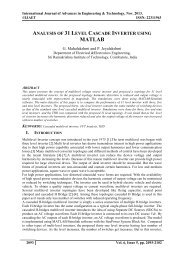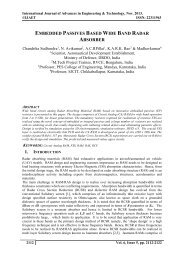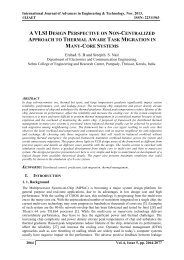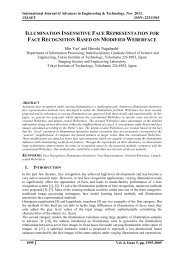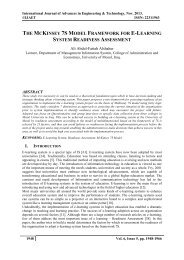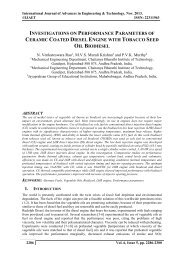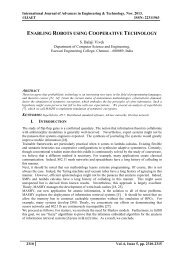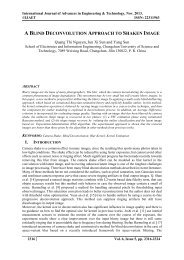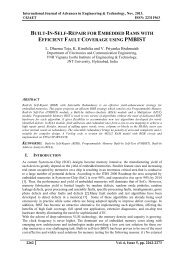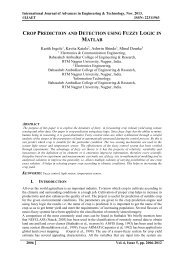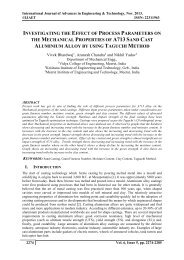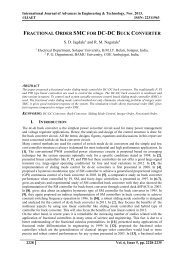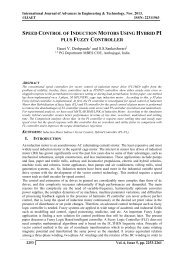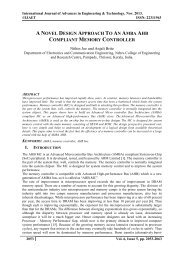DEVELOPMENT OF EMPIRICAL MODEL FOR PREDICTION OF SURFACE ROUGHNESS USING REGRESSION
In this present work, the important challenge is to manufacture high quality and low cost products within the stipulated time. The quality is one of the major factors of the product which depends upon the surface roughness and hence the surface roughness placed an important role in product manufacturing. Hence, an Empirical model is proposed for prediction of surface roughness in machining processes at given cutting conditions. The model considers the following working parameters spindle speed, feed, depth of cut, number of flutes and overhang of the tool. For a given work-tool combination, the range of cutting conditions are selected from different cutting condition variables. The experiments were conducted based on the principle of Factorial Design of Experiment (DOE) method with mixed level. After conducting experiments, surface roughness values are measured. Then these experimental results are used to develop an Empirical model for prediction of surface roughness by using Multiple Regression method. In this the Artificial Intelligence based neural network modelling approach is presented for the prediction of surface roughness of Aluminium Alloy products machined on CNC End Milling using High speed steel tool. Trails were made with different combinations of step size and momentum to select the best learning parameter. The best network structure with least Mean Square Error (MSE) was selected among the several networks. The multiple regression models, which are most widely used as prediction methods, are considered to be compared with the developed Artificial Neural Network (ANN) model performance.
In this present work, the important challenge is to manufacture high quality and low cost products within the stipulated time. The quality is one of the major factors of the product which depends upon the surface roughness and hence the surface roughness placed an important role in product manufacturing. Hence, an Empirical model is proposed for prediction of surface roughness in machining processes at given cutting conditions. The model considers the following working parameters spindle speed, feed, depth of cut, number of flutes and overhang of the tool. For a given work-tool combination, the range of cutting conditions are selected from different cutting condition variables. The experiments were conducted based on the principle of Factorial Design of Experiment (DOE) method with mixed level. After conducting experiments, surface roughness values are measured. Then these experimental results are used to develop an Empirical model for prediction of surface roughness by using Multiple Regression method. In this the Artificial Intelligence based neural network modelling approach is presented for the prediction of surface roughness of Aluminium Alloy products machined on CNC End Milling using High speed steel tool. Trails were made with different combinations of step size and momentum to select the best learning parameter. The best network structure with least Mean Square Error (MSE) was selected among the several networks. The multiple regression models, which are most widely used as prediction methods, are considered to be compared with the developed Artificial Neural Network (ANN) model performance.
You also want an ePaper? Increase the reach of your titles
YUMPU automatically turns print PDFs into web optimized ePapers that Google loves.
International Journal of Advances in Engineering & Technology, Nov. 2013.<br />
©IJAET ISSN: 22311963<br />
[13] Johny Shaida Shaik1, K.Rajasekhara Babu2, (July 2012) Prediction of surface roughness in hard<br />
turning by using fuzzy logic, International Journal of Emerging trends in Engineering and<br />
Development Issue 2, Vol.5.<br />
[14] Mr.Ch. Madhu .V.N, .Prof., A.V.N.L. Sharma, (April 2012) Optimization of cutting parameters for<br />
surface roughness prediction using artificial neural network in cnc turning, IRACST – Engineering<br />
Science and Technology: An International Journal (ESTIJ), ISSN: 2250-3498, Vol.2, No. 2.<br />
[15] Adem Çiçek1, Turgay Kıvak2, Gürcan Samtaş2, − Yusuf Çay3, (2012) Modelling of Thrust Forces in<br />
Drilling of AISI 316 Stainless Steel Using Artificial Neural Network and Multiple Regression<br />
Analysis, Strojniški vestnik - Journal of Mechanical Engineering 58, 7-8, 492-498.<br />
[16] José Luiz S. Ribeiro1, Steve B. Diniz2, Juan Carlos Campos Rubio2, Alexandre M. Abrão2, (2012)<br />
Dimensional and Geometric Deviations Induced by Milling of Annealed and Hardened AISI H13 Tool<br />
Steel, American Journal of Materials Science, 2(1): 14-21.<br />
[17] Jitendra Verma1, Pankaj Agrawal2, Lokesh Bajpai3, (March 2012) Turning parameter optimization for<br />
surface roughness of astm a242 type-1 alloys steel by taguchi method, International Journal of<br />
Advances in Engineering & Technology.<br />
[18] M. Janardhan1 and A. Gopala Krishna2, (March 2012) Multi-objective optimization of cutting<br />
parameters for surface roughness and metal removal rate in surface grinding using response removal<br />
rate in surface grinding using response, International Journal of Advances in Engineering &<br />
Technology.<br />
AUTHORS<br />
P. Shabarish had his engineering education in Mechanical engineering at Rajeev Gandhi<br />
Memorial College of Engineering & Technology, Nandyal and PG in JNTUH College of<br />
Technology, Hyderabad. He is presently working as Senior Software Engineer in iGATE.<br />
He is having 2 years of teaching experience and 2 years of industrial experience. His areas<br />
of interest are Intelligent Manufacturing Systems, Un-Conventional<br />
Machining and Manufacturing process.<br />
2052 Vol. 6, Issue 5, pp. 2041-2052




